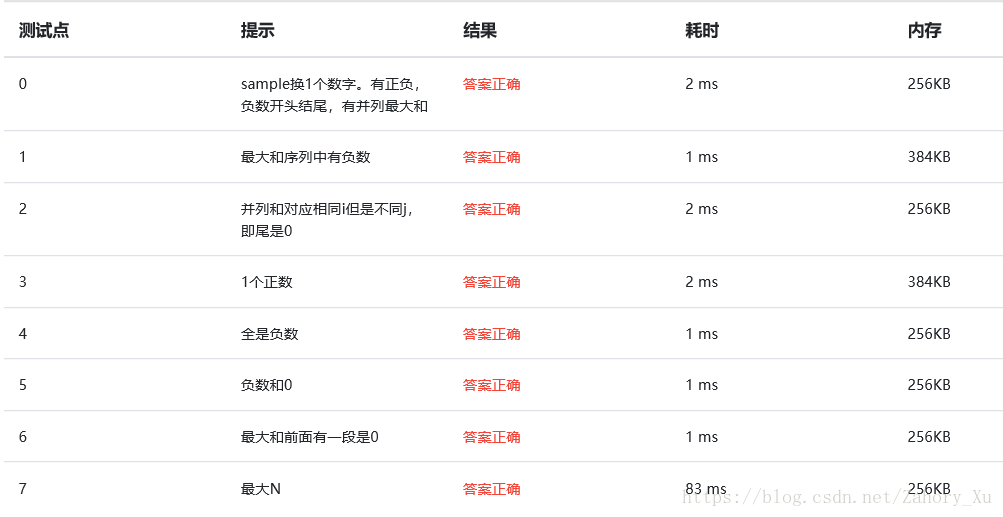- 【算法系列】买卖股票的最佳时机【JS代码】
DTcode7
算法系列#前端基础入门三大核心之JS算法javascript最佳时机
【算法系列】买卖股票的最佳时机【JS代码】问题描述基本概念和作用说明解决方案暴力解法一次遍历法代码示例总结与讨论在前端开发中,虽然我们主要关注的是构建用户界面和交互逻辑,但掌握一些基本的算法和数据结构知识也是非常有用的。今天,我们就来探讨一个经典的问题:“买卖股票的最佳时机”。这个问题看似与前端开发无关,但实际上,它背后的算法思想对于优化我们的程序和解决问题有着极大的帮助。问题描述假设你有一个数组
- ArrayList剖析
weixin_44612246
javaspringboot
大家天天在用List,ArrayList一般来讲应该是程序员用的最多的集合类了。我们今天研究一下ArrayList。总体来讲,从底层数据结构或者源码的角度看,List比Map或者Set要简单。底层数据结构ArryList其实就是可变长数组。初始化的时候,可以指定容量,不指定容量的话,ArrayList被初始化为空数组,首次存入数据的时候才进行容量初始化,初始化最小容量为10。ArrayList的容
- 游戏配置表导出工具深度解析
你一身傲骨怎能输
游戏工具链游戏
文章摘要TableExportTool是一个用于表格数据导出的工具,主要包含表格读取、数据解析、导出和代码生成四大模块。它支持读取Excel/CSV文件,解析字段和类型后转换为JSON、二进制、Lua等多种格式,并自动生成C#、Lua等数据结构代码。工具还提供Unity集成功能,支持一键导出、Asset生成和热更新。核心流程包括读取表头、类型校验、数据组装和导出,通过NPOI/EPPlus实现表格
- 【深度学习pytorch-6】张量与numpy相互转换
超华东算法王
DL-pytorch深度学习pytorchnumpy
张量与Numpy数组之间的互相转换在深度学习中,张量(tensor)和Numpy数组(numpyarray)是两种常见的数据结构。张量通常用于深度学习框架(如PyTorch、TensorFlow等),而Numpy数组在科学计算中被广泛使用。为了便于数据处理和计算,常常需要在它们之间进行转换。下面介绍张量和Numpy数组之间的互相转换。1.PyTorch张量与Numpy数组的互相转换PyTorch提
- Java基础 集合框架 队列架构 阻塞双端队列BlockingDeque架构
BlockingDequeBlockingDeque核心特性BlockingDeque核心方法唯一标准实现:LinkedBlockingDequeLinkedBlockingDeque构造方法LinkedBlockingDeque数据结构及管理逻辑LinkedBlockingDeque核心特性LinkedBlockingDeque核心操作方法逻辑LinkedBlockingDeque总结Linke
- 27.访问者模式
原文地址:访问者模式更多内容请关注:智想天开1.访问者模式简介访问者模式(VisitorPattern)是一种行为型设计模式,它允许在不改变元素类的前提下,向元素添加新的操作。通过将操作封装到访问者对象中,访问者模式实现了操作与数据结构的分离,使得可以在不修改元素类的情况下,新增操作。关键点:操作封装:将不同的操作封装到独立的访问者类中。分离数据结构与操作:访问者模式将数据结构(元素类)与对其执行
- Redis总结
傲祥Ax
redis数据库Redis重点总结
一、Redis是什么?key-value形式的非关系型数据库,基于内存(64位系统默认是物理内存的四分之三),单线程多路io复用,通常当缓存使用,提高查询效率。二、为什么使用Redis?2.1快(内单异高算)内存存储,单线程模型,异步操作,高效的网络通信,优化的算法和数据结构2.2作用2.2.1五大数据类型Redis存储,key-value形式,value的五种数据类型String,List,Se
- (C++)学生管理系统(测试版)(map数组的应用)(string应用)(引用)(C++教学)(C++项目)
双叶836
C++基础教学STLC++C++项目c++算法开发语言数据结构后端
源代码:#include//输入输出流库,提供cin/cout等基本I/O功能#include//映射容器库,提供map数据结构(键值对集合)#include//字符串库,提供string类及字符串操作#include//输入输出格式化库,提供setw等格式化控制usingnamespacestd;//使用标准命名空间,避免写std::前缀//定义学生结构体:包含多个相关数据的复合类型struct
- 分布式锁的实现方式:使用 Redisson 实现分布式锁( Spring Boot )
weixin_43833540
分布式springboot后端
Redisson提供了分布式和可扩展的Java数据结构,包括分布式锁的实现。1.添加依赖在pom.xml中添加Redisson依赖:org.redissonredisson-spring-boot-starter3.16.42.配置Redisson客户端创建Redisson配置类:importorg.redisson.Redisson;importorg.redisson.api.Redisson
- 「日拱一码」014 Python常用库——Pandas
目录数据结构pandas.Series:一维数组,类似于数组,但索引可以是任意类型,而不仅仅是整数pandas.DataFrame:二维表格型数据结构,类似于Excel表格,每列可以是不同的数据类型数据读取与写入读取数据pd.read_csv():读取CSV文件pd.read_excel():读取Excel文件pd.read_sql():从数据库读取数据写入数据DataFrame.to_csv()
- 【数据结构】二叉树
nanguochenchuan
数据结构数据结构算法
二叉树的基本概念二叉树是每个节点最多有两个子节点的树结构,这两个子节点分别称为左子节点和右子节点。与普通树相比,二叉树具有更严格的结构限制:根节点:最顶层的节点,没有父节点叶子节点:没有子节点的末端节点子树:某个节点及其所有后代组成的树深度:从根节点到该节点的路径长度(根节点深度为0)高度:从节点到最深叶子节点的路径长度(叶子节点高度为0)与普通树的区别:普通树节点可以有任意数量的子节点二叉树严格
- 【数据结构】排序算法:冒泡与快速
nanguochenchuan
数据结构排序算法数据结构算法
引言:排序算法的重要性排序算法是计算机科学的基础核心,直接影响程序性能和资源消耗。在C语言开发中,理解不同排序算法的特性对编写高效代码至关重要。本文将深入分析两种经典排序算法:简单直观的冒泡排序和高效快速的快速排序,并提供完整的C语言实现。冒泡排序:简单但低效基本思想冒泡排序通过相邻元素比较交换,使较大元素逐渐移动到数组末端,如同气泡上浮。C语言实现#includevoidbubbleSort(i
- 小白学习Python的系统化路径
python观点资讯
学好Python需要系统化的学习和持续的实践,尤其对于小白来说,从基础到进阶需要循序渐进。以下是一份清晰的学习路径和建议,帮助你高效掌握Python:1.打好基础核心语法变量与数据类型:整数、浮点数、字符串、布尔值等。运算符:算术、比较、逻辑运算符。流程控制:if-else条件判断、for/while循环。函数:定义函数、参数传递、返回值、作用域。数据结构:列表、元组、字典、集合的常用操作。推荐资
- 嵌套列表与二维列表的遍历方法
在Python的世界中,列表(list)是最为基础而强大的数据结构之一。而当一个列表的元素本身又是列表时,我们便进入了嵌套列表(NestedList)或更通用的二维列表(2DList)的语境中。无论是在软件开发、测试数据构造、数据分析、机器学习、自动化运维还是教育教学场景中,嵌套结构的遍历与处理都是工程能力的一项基本功。本文将系统剖析Python中处理嵌套列表和二维列表的常用遍历方式,从基础语法到
- 【数据结构】常见七大排序总结
多多钟意你吖
阶段一:数据结构数据结构排序算法算法java
目录一、插入排序:直接插入排序【稳定排序方法】二、插入排序:希尔排序【不稳定排序方法】三、选择排序:直接选择排序【不稳定排序方法】四、选择排序:堆排序【不稳定排序方法】五、交换排序:冒泡排序【稳定排序方法】六、交换排序:快速排序【不稳定排序方法】七、归并排序:归并排序【稳定排序方法】前言排序是计算机程序设计中的一种重要操作,其功能是对一个数据元素集合或序列重新排列成一个按数据元素某个相知有序的序列
- Redis学习总结(15)——Redis 基本数据类型使用场景
一杯甜酒
RedisRedis基本数据类型使用场景
一、StringStrings数据结构是简单的key-value类型,value其实不仅是String,也可以是数字.常用命令:set,get,decr,incr,mget等。应用场景:String是最常用的一种数据类型,普通的key/value存储都可以归为此类.即可以完全实现目前Memcached的功能,并且效率更高。还可以享受Redis的定时持久化,操作日志及Replication等功能。除
- 量子算法:微算法科技用于定位未知哈希图的量子算法,网络安全中的哈希映射突破
MicroTech2025
量子计算哈希算法
近年来,量子计算的飞速发展使其成为各个领域的变革力量。特别是在网络安全领域,量子算法展示了加速并增强威胁检测(如恶意软件识别)方法的巨大潜力。微算法科技(NASDAQ:MLGO)用于定位未知哈希图的量子算法,是针对未知哈希图定位而设计的量子算法。这项技术可能会彻底改变在数据处理中利用哈希值的方式,特别是在恶意软件模式识别中。传统网络安全框架通常依赖哈希函数来生成不同数据结构的唯一标识符,或称之为“
- Python-什么是集合
難釋懷
python开发语言数据库
一、前言在Python中,除了我们常用的列表(list)、元组(tuple)和字典(dict),还有一种非常实用的数据结构——集合(set)。集合是一种无序且不重复的元素集合,常用于去重、交并差运算等场景。本文将带你全面了解Python中集合的基本用法、操作方法及其适用场景,并通过大量代码示例帮助你掌握这一重要数据类型。二、什么是集合(set)?✅定义:集合是Python中的一种可变数据类型,它存
- 数据结构—数组
每天一个秃顶小技巧
数据结构golang后端
数据结构—数组相关数据结构实现用go语言实现相关代码做题合集:https://github.com/longpi1/algorithm-pattern数组(Array)在Go中,数组是固定长度的连续内存块,长度在定义时确定且不可变。数组的使用场景较少,因为切片(slice)更加灵活,通常更常用。所以在做算法题时一般用切片进行编写定义和特点数组的长度是类型的一部分,例如[3]int和[4]int是不
- Python元组的遍历
難釋懷
python前端linux
一、前言在Python中,元组(tuple)是一种非常基础且常用的数据结构,它与列表类似,都是有序的序列,但不同的是,元组是不可变的(immutable),一旦创建就不能修改。虽然元组不能被修改,但它支持高效的遍历操作,非常适合用于存储不会变化的数据集合。本文将系统性地介绍Python中元组的多种遍历方式,包括基本遍历、索引访问、元素解包、结合函数等,并结合大量代码示例帮助你掌握这一重要技能。二、
- Python开发从新手到专家:第三章 列表、元组和集合
caifox菜狐狸
Python开发从新手到专家python元素集合列表元组数据结构字典
在Python开发的旅程中,数据结构是每一位开发者必须掌握的核心知识。它们是构建程序的基石,决定了代码的效率、可读性和可维护性。本章将深入探讨Python中的三种基本数据结构:列表、元组和集合。这三种数据结构在实际开发中有着广泛的应用,从简单的数据存储到复杂的算法实现,它们都扮演着不可或缺的角色。无论你是刚刚接触Python的新手,还是希望进一步提升编程技能的开发者,本章都将是你的宝贵指南。我们将
- 数据结构学习之栈
楼田莉子
数据结构学习笔记算法数据结构c语言
本篇博客我们将深入学习数据结构中栈与队列相关的内容作者的个人gitee:楼田莉子(riko-lou-tian)-Gitee.com目录概念栈的实现初始化销毁入栈判空出栈获取栈顶元素栈的有效元素个数源代码与栈相关的算法题(力扣)有效的括号编辑概念栈是一种特殊的线性表,只允许在固定的一端进行插入删除元素的操作。进行数据插入和删除操作的一端叫栈顶,另一端叫栈底。遵循“后进先出”的原则。下图就是对栈后进先
- JavaScript数组方法
whhhhhhhhhw
javascript开发语言ecmascript前端html
前言:JavaScript这门强大而灵活的编程语言中,数组(Array)无疑是最基础且使用最频繁的数据结构之一。它允许我们以有序的方式存储多个值,并提供了丰富的内置方法来操作这些值,包括但不限于添加、删除、搜索、遍历等。掌握JavaScript数组的方法,不仅能够提高我们的编程效率,还能让我们在处理复杂数据结构时更加得心应手。本文将全面解析JavaScript数组的各种常用方法,并通过实战示例展示
- Redis 功能扩展:Lua 脚本对 Redis 的扩展
cici15874
redislua数据库
Redis是一个高性能的内存数据库,支持多种数据结构,如字符串、哈希、列表、集合和有序集合。为了增强其功能,Redis引入了Lua脚本支持,使开发者可以编写自定义的脚本,确保操作的原子性并提高复杂操作的性能。本文将详细介绍如何使用Lua脚本对Redis进行扩展,重点讲解eval命令、redis.call和redis.pcall的用法。一、Lua脚本在Redis中的作用Lua脚本在Redis中的主要
- Python的内存管理
星辰灬
Pythonpythonpycharm
Python的内存管理在Python中,内存管理涉及到一个包含所有Python对象和数据结构的私有堆(heap)。这个私有堆的管理由内部的Python内存管理器(Pythonmemorymanager)保证。Python内存管理器有不同的组件来处理各种动态存储管理方面的问题,如共享、分割、预分配或缓存。内存管理机制动态内存分配:Python使用动态内存分配,这意味着它在运行时动态分配和管理内存,而
- 教育技术学读计算机论文的提示词
东方-教育技术博主
学术学习相关AI
角色:你是一位经验丰富的计算机专业教授,擅长用通俗易懂的语言向初学者解释复杂概念。我现在正在学习阅读计算机科学领域的算法论文,但我的基础比较薄弱(了解编程基础如变量、循环、函数,了解一点数据结构和算法概念如数组、链表、排序,但对高级术语和数学证明不熟悉)。同时又是一个教育技术学教授。任务:请帮我解释以下论文内容中我不理解的部分。如果遇到初学者可能不懂的地方,我需要你用最清晰、最简洁、最易懂的方式解
- 【Linux】写时拷贝——干货解析
代码程序猿RIP
Linuxlinux运维服务器
提示:文章写完后,目录可以自动生成,如何生成可参考右边的帮助文档文章目录一、写时拷贝核心概念1.什么是写时拷贝?2.COW解决的问题二、写时拷贝工作原理1.内存管理基础结构2.COW工作流程3.页表状态变化图示初始状态(共享只读)子进程写入后(写时拷贝)三、写时拷贝的优势分析1.性能优势对比2.实际性能数据3.资源利用率提升四、内核实现深度解析1.COW核心代码逻辑2.关键数据结构五、应用场景与最
- 数据结构学习——动态数组C#实现
xiaojuese255
数据结构学习c#
1数组1.1静态数组int[]float[]double[]char[]string[]特点:一旦创建,其容量的大小无法改变int[]arr=newint[20];1.2动态数组:ArrayListList泛型列表可以根据元素的多少动态地调整数组容量的大小1.3装箱和拆箱装箱:值类型转换为引用类型拆箱:引用类型转换为值类型,只有装过箱的对象才能拆箱ArrayLista=newArrayList()
- 数据结构day6——内核链表
LZA185
数据结构数据结构链表
在Linux内核开发中,链表是最基础且重要的数据结构之一。与普通链表不同,Linux内核采用了一种非常巧妙的"通用链表"设计,它不直接包含数据,而是将数据结构嵌入其中,从而实现了一种高度灵活、可复用的链表机制。本文将深入解析Linux内核链表的设计思想、实现原理及应用场景。一、传统链表的局限性传统链表的实现方式通常是将数据直接包含在节点结构中://传统链表节点结构typedefstructStud
- 数据结构day5——队列和树
LZA185
数据结构数据结构
目录一、队列:先进先出的数据缓冲区队列的核心概念队列的典型应用场景队列的基本操作队列的两种C语言实现方式1.顺序队列(基于数组的实现)2.循环队列(解决假溢出问题)二、树:一对多的层次结构树的基本概念树的存储方式二叉树:最常用的树结构二叉树的定义二叉树的特点特殊的二叉树二叉树的重要特性二叉树的C语言实现与遍历三、总结在数据结构的世界里,队列和树是两种截然不同却又同样重要的结构。队列以其"先进先出"
- scala的option和some
矮蛋蛋
编程scala
原文地址:
http://blog.sina.com.cn/s/blog_68af3f090100qkt8.html
对于学习 Scala 的 Java™ 开发人员来说,对象是一个比较自然、简单的入口点。在 本系列 前几期文章中,我介绍了 Scala 中一些面向对象的编程方法,这些方法实际上与 Java 编程的区别不是很大。我还向您展示了 Scala 如何重新应用传统的面向对象概念,找到其缺点
- NullPointerException
Cb123456
androidBaseAdapter
java.lang.NullPointerException: Attempt to invoke virtual method 'int android.view.View.getImportantForAccessibility()' on a null object reference
出现以上异常.然后就在baidu上
- PHP使用文件和目录
天子之骄
php文件和目录读取和写入php验证文件php锁定文件
PHP使用文件和目录
1.使用include()包含文件
(1):使用include()从一个被包含文档返回一个值
(2):在控制结构中使用include()
include_once()函数需要一个包含文件的路径,此外,第一次调用它的情况和include()一样,如果在脚本执行中再次对同一个文件调用,那么这个文件不会再次包含。
在php.ini文件中设置
- SQL SELECT DISTINCT 语句
何必如此
sql
SELECT DISTINCT 语句用于返回唯一不同的值。
SQL SELECT DISTINCT 语句
在表中,一个列可能会包含多个重复值,有时您也许希望仅仅列出不同(distinct)的值。
DISTINCT 关键词用于返回唯一不同的值。
SQL SELECT DISTINCT 语法
SELECT DISTINCT column_name,column_name
F
- java冒泡排序
3213213333332132
java冒泡排序
package com.algorithm;
/**
* @Description 冒泡
* @author FuJianyong
* 2015-1-22上午09:58:39
*/
public class MaoPao {
public static void main(String[] args) {
int[] mao = {17,50,26,18,9,10
- struts2.18 +json,struts2-json-plugin-2.1.8.1.jar配置及问题!
7454103
DAOspringAjaxjsonqq
struts2.18 出来有段时间了! (貌似是 稳定版)
闲时研究下下! 貌似 sruts2 搭配 json 做 ajax 很吃香!
实践了下下! 不当之处请绕过! 呵呵
网上一大堆 struts2+json 不过大多的json 插件 都是 jsonplugin.34.jar
strut
- struts2 数据标签说明
darkranger
jspbeanstrutsservletScheme
数据标签主要用于提供各种数据访问相关的功能,包括显示一个Action里的属性,以及生成国际化输出等功能
数据标签主要包括:
action :该标签用于在JSP页面中直接调用一个Action,通过指定executeResult参数,还可将该Action的处理结果包含到本页面来。
bean :该标签用于创建一个javabean实例。如果指定了id属性,则可以将创建的javabean实例放入Sta
- 链表.简单的链表节点构建
aijuans
编程技巧
/*编程环境WIN-TC*/ #include "stdio.h" #include "conio.h"
#define NODE(name, key_word, help) \ Node name[1]={{NULL, NULL, NULL, key_word, help}}
typedef struct node { &nbs
- tomcat下jndi的三种配置方式
avords
tomcat
jndi(Java Naming and Directory Interface,Java命名和目录接口)是一组在Java应用中访问命名和目录服务的API。命名服务将名称和对象联系起来,使得我们可以用名称
访问对象。目录服务是一种命名服务,在这种服务里,对象不但有名称,还有属性。
tomcat配置
- 关于敏捷的一些想法
houxinyou
敏捷
从网上看到这样一句话:“敏捷开发的最重要目标就是:满足用户多变的需求,说白了就是最大程度的让客户满意。”
感觉表达的不太清楚。
感觉容易被人误解的地方主要在“用户多变的需求”上。
第一种多变,实际上就是没有从根本上了解了用户的需求。用户的需求实际是稳定的,只是比较多,也比较混乱,用户一般只能了解自己的那一小部分,所以没有用户能清楚的表达出整体需求。而由于各种条件的,用户表达自己那一部分时也有
- 富养还是穷养,决定孩子的一生
bijian1013
教育人生
是什么决定孩子未来物质能否丰盛?为什么说寒门很难出贵子,三代才能出贵族?真的是父母必须有钱,才能大概率保证孩子未来富有吗?-----作者:@李雪爱与自由
事实并非由物质决定,而是由心灵决定。一朋友富有而且修养气质很好,兄弟姐妹也都如此。她的童年时代,物质上大家都很贫乏,但妈妈总是保持生活中的美感,时不时给孩子们带回一些美好小玩意,从来不对孩子传递生活艰辛、金钱来之不易、要懂得珍惜
- oracle 日期时间格式转化
征客丶
oracle
oracle 系统时间有 SYSDATE 与 SYSTIMESTAMP;
SYSDATE:不支持毫秒,取的是系统时间;
SYSTIMESTAMP:支持毫秒,日期,时间是给时区转换的,秒和毫秒是取的系统的。
日期转字符窜:
一、不取毫秒:
TO_CHAR(SYSDATE, 'YYYY-MM-DD HH24:MI:SS')
简要说明,
YYYY 年
MM 月
- 【Scala六】分析Spark源代码总结的Scala语法四
bit1129
scala
1. apply语法
FileShuffleBlockManager中定义的类ShuffleFileGroup,定义:
private class ShuffleFileGroup(val shuffleId: Int, val fileId: Int, val files: Array[File]) {
...
def apply(bucketId
- Erlang中有意思的bug
bookjovi
erlang
代码中常有一些很搞笑的bug,如下面的一行代码被调用两次(Erlang beam)
commit f667e4a47b07b07ed035073b94d699ff5fe0ba9b
Author: Jovi Zhang <
[email protected]>
Date: Fri Dec 2 16:19:22 2011 +0100
erts:
- 移位打印10进制数转16进制-2008-08-18
ljy325
java基础
/**
* Description 移位打印10进制的16进制形式
* Creation Date 15-08-2008 9:00
* @author 卢俊宇
* @version 1.0
*
*/
public class PrintHex {
// 备选字符
static final char di
- 读《研磨设计模式》-代码笔记-组合模式
bylijinnan
java设计模式
声明: 本文只为方便我个人查阅和理解,详细的分析以及源代码请移步 原作者的博客http://chjavach.iteye.com/
import java.util.ArrayList;
import java.util.List;
abstract class Component {
public abstract void printStruct(Str
- 利用cmd命令将.class文件打包成jar
chenyu19891124
cmdjar
cmd命令打jar是如下实现:
在运行里输入cmd,利用cmd命令进入到本地的工作盘符。(如我的是D盘下的文件有此路径 D:\workspace\prpall\WEB-INF\classes)
现在是想把D:\workspace\prpall\WEB-INF\classes路径下所有的文件打包成prpall.jar。然后继续如下操作:
cd D: 回车
cd workspace/prpal
- [原创]JWFD v0.96 工作流系统二次开发包 for Eclipse 简要说明
comsci
eclipse设计模式算法工作swing
JWFD v0.96 工作流系统二次开发包 for Eclipse 简要说明
&nb
- SecureCRT右键粘贴的设置
daizj
secureCRT右键粘贴
一般都习惯鼠标右键自动粘贴的功能,对于SecureCRT6.7.5 ,这个功能也已经是默认配置了。
老版本的SecureCRT其实也有这个功能,只是不是默认设置,很多人不知道罢了。
菜单:
Options->Global Options ...->Terminal
右边有个Mouse的选项块。
Copy on Select
Paste on Right/Middle
- Linux 软链接和硬链接
dongwei_6688
linux
1.Linux链接概念Linux链接分两种,一种被称为硬链接(Hard Link),另一种被称为符号链接(Symbolic Link)。默认情况下,ln命令产生硬链接。
【硬连接】硬连接指通过索引节点来进行连接。在Linux的文件系统中,保存在磁盘分区中的文件不管是什么类型都给它分配一个编号,称为索引节点号(Inode Index)。在Linux中,多个文件名指向同一索引节点是存在的。一般这种连
- DIV底部自适应
dcj3sjt126com
JavaScript
<!DOCTYPE html PUBLIC "-//W3C//DTD XHTML 1.0 Transitional//EN" "http://www.w3.org/TR/xhtml1/DTD/xhtml1-transitional.dtd">
<html xmlns="http://www.w3.org/1999/xhtml&q
- Centos6.5使用yum安装mysql——快速上手必备
dcj3sjt126com
mysql
第1步、yum安装mysql
[root@stonex ~]# yum -y install mysql-server
安装结果:
Installed:
mysql-server.x86_64 0:5.1.73-3.el6_5 &nb
- 如何调试JDK源码
frank1234
jdk
相信各位小伙伴们跟我一样,想通过JDK源码来学习Java,比如collections包,java.util.concurrent包。
可惜的是sun提供的jdk并不能查看运行中的局部变量,需要重新编译一下rt.jar。
下面是编译jdk的具体步骤:
1.把C:\java\jdk1.6.0_26\sr
- Maximal Rectangle
hcx2013
max
Given a 2D binary matrix filled with 0's and 1's, find the largest rectangle containing all ones and return its area.
public class Solution {
public int maximalRectangle(char[][] matrix)
- Spring MVC测试框架详解——服务端测试
jinnianshilongnian
spring mvc test
随着RESTful Web Service的流行,测试对外的Service是否满足期望也变的必要的。从Spring 3.2开始Spring了Spring Web测试框架,如果版本低于3.2,请使用spring-test-mvc项目(合并到spring3.2中了)。
Spring MVC测试框架提供了对服务器端和客户端(基于RestTemplate的客户端)提供了支持。
&nbs
- Linux64位操作系统(CentOS6.6)上如何编译hadoop2.4.0
liyong0802
hadoop
一、准备编译软件
1.在官网下载jdk1.7、maven3.2.1、ant1.9.4,解压设置好环境变量就可以用。
环境变量设置如下:
(1)执行vim /etc/profile
(2)在文件尾部加入:
export JAVA_HOME=/home/spark/jdk1.7
export MAVEN_HOME=/ho
- StatusBar 字体白色
pangyulei
status
[[UIApplication sharedApplication] setStatusBarStyle:UIStatusBarStyleLightContent];
/*you'll also need to set UIViewControllerBasedStatusBarAppearance to NO in the plist file if you use this method
- 如何分析Java虚拟机死锁
sesame
javathreadoracle虚拟机jdbc
英文资料:
Thread Dump and Concurrency Locks
Thread dumps are very useful for diagnosing synchronization related problems such as deadlocks on object monitors. Ctrl-\ on Solaris/Linux or Ctrl-B
- 位运算简介及实用技巧(一):基础篇
tw_wangzhengquan
位运算
http://www.matrix67.com/blog/archives/263
去年年底写的关于位运算的日志是这个Blog里少数大受欢迎的文章之一,很多人都希望我能不断完善那篇文章。后来我看到了不少其它的资料,学习到了更多关于位运算的知识,有了重新整理位运算技巧的想法。从今天起我就开始写这一系列位运算讲解文章,与其说是原来那篇文章的follow-up,不如说是一个r
- jsearch的索引文件结构
yangshangchuan
搜索引擎jsearch全文检索信息检索word分词
jsearch是一个高性能的全文检索工具包,基于倒排索引,基于java8,类似于lucene,但更轻量级。
jsearch的索引文件结构定义如下:
1、一个词的索引由=分割的三部分组成: 第一部分是词 第二部分是这个词在多少
